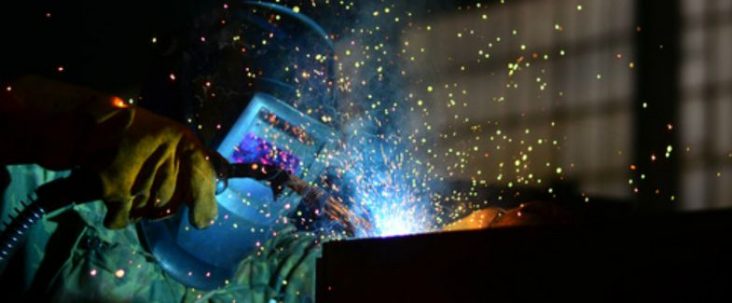Pakko previews forecast, says manufacturing jobs growing faster than others
by November 7, 2019 8:17 am 443 views

Manufacturing employment in Arkansas has been growing faster than in the rest of the economy the past 18-20 months, while overall job growth has occurred mostly in Northwest Arkansas, central Arkansas and Jonesboro.
That’s according to Dr. Michael Pakko, chief economist and state economic forecaster at the University of Arkansas at Little Rock’s Arkansas Economic Development Institute.
Pakko discussed the numbers at an American Council of Engineering Companies of Arkansas event Wednesday (Nov. 6). He described his remarks as a “preview” of his annual economic forecast, which he will present Nov. 14 at the Clinton Library.
Pakko said Arkansas has experienced a resurgence in manufacturing hiring. Manufacturing is still the largest component of economic output, representing 15.3% of the gross state product from 2014-18.
The sector lost 35,000 jobs over an 11-year period from 2007 to 2018, while the service sector grew. But in the most recent period from 2013-19, manufacturing and construction jobs have increased along with other sectors other than mining and logging.
“There’s a more balanced growth that we’re seeing now than we did in the first five years of this expansion, and (that’s) a trend that I expect to continue,” he said.
Over the past 18-20 months, manufacturing employment has grown faster than in the rest of the Arkansas economy, which Pakko said is good news for certain parts of the state. While the more prosperous Northwest Arkansas and Little Rock metropolitan areas are characterized by service sector jobs, manufacturing jobs are more evenly dispersed around the state.
“The growth in manufacturing jobs has taken place in those areas of the state that have been left behind previously … in this expansion,” he said.
Pakko said Arkansas’ economy has been on a steady growth trend since 2014 after it experienced a double dip recession in 2012-13.
But job growth has been concentrated in the state’s most prosperous areas. From 2013 to 2018, 53.9% of the state’s job growth was in Northwest Arkansas, 29.5% was in Little Rock, and 9.3% was in Jonesboro. The rest of the state, which has 45% of the jobs, saw only 7% of total job growth.
The number of jobs has increased 28% in Northwest Arkansas since before the recession, 22% in Jonesboro, and 5% in Little Rock. But fewer people are working in other metro areas, and Pine Bluff is down 13.5% from pre-recession levels. Forty-two counties have lower employment today than they did at the onset of the decade.
The U.S. economic expansion has reached 10 years and is the longest in modern American history, but it’s been characterized by moderate, not rapid growth. Pakko expects growth to settle in the 2-2.5% range over the next couple of years.
Arkansas is growing more slowly than the rest of the nation. The U.S. economy has grown an average of 2.6% over the last five years, while Arkansas’ has grown 1%.
One reason for the gap is that Arkansas’ population is growing half as fast as the U.S. population – .35% annually vs. .7%.
“People follow jobs, so if the economy is doing well, you’re going to see population growth pick up,” he said.
Pakko said only 26 of the state’s 75 counties experienced population growth from the last census in 2010 to 2018, while 49 counties are shrinking.
He said personal income in Arkansas has grown 4.2% annually in Arkansas, almost as fast as the national average of 4.4%.
But that growth is concentrated among wealthier Arkansans. Dividends, interest and rent have been growing 8.2% annually the past eight years here, compared to 6.5% nationwide. In wages and salaries, Arkansas has seen only 3.5% growth, compared to a national rate of 4.5%. Wages and salaries have accounted for 48.7% of personal income growth nationwide since 2010 but only 37.5% in Arkansas. Dividends, interest and rent have accounted for 38.4% of personal income growth in Arkansas and 26.4% nationally.
The slower rate of wage and salary income growth has been a drag on consumption spending growth in Arkansas, which trailed the national average in 2012-16 but has been increasing at about the same pace since then.
The unemployment rate in Arkansas has held steady at 3.5%, a rate that recently was equalled by the national average. That low rate is unprecedented in Arkansas.
But it masks some deeper economic realities that are not as positive, because the unemployment rate does not take into account individuals who have stopped looking for jobs and have left the labor force. The labor force participation rate in Arkansas has dropped from 63% in about 2008 to 58%, while nationally it has dropped from 66% to 63%.
Pakko said the best measurement for labor market slack is the employment population ratio – how many people have jobs compared to the entire population. In Arkansas, that number has fallen from 60% in 2007 to 56% now.
“So about 4% of Arkansas’ population was working before the recession and is not working now,” he said.
